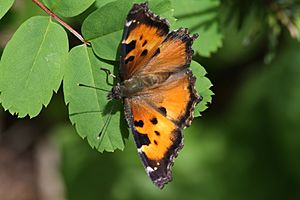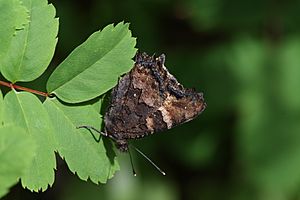California tortoiseshell facts for kids
Quick facts for kids California tortoiseshell |
|
|---|---|
 |
|
| Scientific classification |

The California tortoiseshell (Nymphalis californica) is a type of butterfly found in North America. It belongs to the Nymphalidae family, which includes many well-known butterflies. This butterfly is special because its numbers can suddenly grow very large. When this happens, they often fly to new places.
Contents
What Makes the California Tortoiseshell Special?
The California tortoiseshell is known for its amazing population explosions. This means that sometimes, there are huge numbers of these butterflies all at once! Scientists are still trying to figure out why these big increases happen. During these times, you might see many butterflies flying together as they move to new areas.
What Do They Look Like?
This butterfly has very distinctive wings. The top side of its wings is a bright orange color with large black spots. This pattern helps the butterfly blend in with its surroundings, acting as a kind of camouflage.
When the California tortoiseshell closes its wings, the underside looks very different. It has shades of brown and gray, making it look a lot like a dead leaf. This helps the butterfly hide from animals that might want to eat it.
How Big Are They?
The wingspan of a California tortoiseshell can vary quite a bit. It usually measures from 3.2 to 7 cm (1+1⁄4–2+3⁄4 inches) across. That's about the size of a small to medium-sized cookie!
What Do California Tortoiseshell Caterpillars Eat?
The young butterflies, called larvae or caterpillars, have a specific diet. They mostly eat different kinds of plants from the Ceanothus family. These plants are common in many parts of California and other western areas.
Who Preys on California Tortoiseshells?
Even though they have good camouflage, California tortoiseshell butterflies can become food for other animals. Ravens are one type of bird that sometimes eats these butterflies. Ravens are smart birds that eat many different things. They are most likely to hunt California tortoiseshells when there are a lot of butterflies during those big population explosions.

